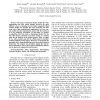Free Online Productivity Tools
i2Speak
i2Symbol
i2OCR
iTex2Img
iWeb2Print
iWeb2Shot
i2Type
iPdf2Split
iPdf2Merge
i2Bopomofo
i2Arabic
i2Style
i2Image
i2PDF
iLatex2Rtf
Sci2ools
ISDA
2010
IEEE
2010
IEEE
Self-adaptive Gaussian mixture models for real-time video segmentation and background subtraction
The usage of Gaussian mixture models for video segmentation has been widely adopted. However, the main difficulty arises in choosing the best model complexity. High complex models can describe the scene accurately, but they come with a high computational requirements, too. Low complex models promote segmentation speed, with the drawback of a less exhaustive description. In this paper we propose an algorithm that first learns a description mixture for the first video frames, and then it uses these results as a starting point for the analysis of the further frames. Then, we apply it to a video sequence and show its effectiveness for real-time tracking multiple moving objects. Moreover, we integrated this procedure into a foreground/background subtraction statistical framework. We compare our procedure against the state-ofthe-art alternatives, and we show both its initialization efficacy and its improved segmentation performance. Keywords-Real-Time Video Segmentation; Self-Adapting Gaussi...
| Added | 05 Mar 2011 |
| Updated | 05 Mar 2011 |
| Type | Journal |
| Year | 2010 |
| Where | ISDA |
| Authors | Nicola Greggio, Alexandre Bernardino, Cecilia Laschi, Paolo Dario, José Santos-Victor |
Comments (0)

